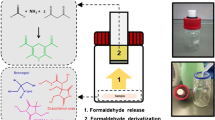Abstract
Trace-level determinations for the presence of formaldehyde in both bulk and dosage form pharmaceuticals were developed using three innovative strategies. One system adapted the chromotropic acid spot test for formaldehyde. This was accomplished spectrophotometrically over a linear detection range against authentic control samples. The other two chromatographic approaches necessitated rapid derivatization. One derivative was its corresponding oxime, formaldoxime, which was resolved on a gas chromatographic porous polymer column and sensed by a nitrogen-specific detector. The other derivative, sodium formate, was detected and quantified on an ion chromatograph using an anion-exchange column and a conductivity detector. The chromotropic acid technique was sensitive but not specific for formaldehyde. The chromatographic techniques required a high degree of water solubility. All were subject to interferences that could preclude their use for a particular application. None of the tested samples, which included a penicillin analogue, a pharmaceutical dosage form additive, a vitamin, and biological proteins, showed the presence of formaldehyde at trace levels.
Similar content being viewed by others
REFERENCES
L. G. Wayne and R. J. Bryan. Irritant Effects of Industrial Chemicals Formaldehyde, DHEW (NIOSH) Publication No. 77-117, Cincinnati, Ohio, 1976.
F. Perera and C. Petito. Formaldehyde: A question of cancer policy? Science 216:1285–1291 (1982).
C. C. Yao and G. C. Miller. Research Study on Bis(Chloromethyl)Ether Formation and Detection in Selected Work Environments, DHEW (NIOSH) Publication No. 79-118, Cincinnati, Ohio 1979.
G. Chiavari, M. C. Laghi, and G. Torsi. High performance liquid chromatographic analysis of aldehydes at trace level as their 3-methylbenzothiazolone azine derivatives. J. Chromatogr. 475:343–351 (1989).
W. R. Summers. Characterization of formaldehyde and formaldehyde-releasing preservatives by combined reversed-phase cation-exchange high-performance liquid chromatography with postcolumn derivatization using Nash's reagent. Anal. Chem. 62:1397–1402 (1990).
J. Brandrup and E. H. Immergut (eds.). Polymer Handbook, Third Edition, John Wiley & Sons, New York, 1989, Vol. VII, pp. 289–290.
F. F. Andrawes. Analysis of liquid samples by capillary gas chromatography and helium ionization detection. J. Chromatogr. 290:65–74 (1984).
U. Platt and D. Perner. Measurements of atmospheric trace gases by long path differential UV/visible absorption spectroscopy. Springer Ser. Opt. Sci. (Opt. Laser Remote Sens.) 39:97–105 (1983).
C. Honeybourne and G. Smith. The digitization of rotational fine structure as a data base for pattern recognition analysis of wet gas mixtures: A feasibility study. Can. J. Spectrosc. 27(5):127–131 (1982).
AOAC Official Methods of Analysis, 20.079 (1984).
M. P. Muñoz, F. J. M. dV Rueda, and L. M. P. Diez. Determination of formaldehyde in air by flow injection using pararosaniline and spectrophotometric detection. Analyst 114:1469–1471 (1989).
M. Okamoto and F. Yamada. Microdetermination of free formaldehyde in commercial clothes by high performance liquid chromatography. Yakugaku Zasshi 101(4):378–381 (1981).
K. Kobayashi, M. Okamoto, and S. Kawai. Microdetermination of free formaldehyde in commercial clothes by gas chromatography. Bunseki Kogaku 30(1):76–78 (1981).
E. Sawicki, T. Hauser, T. Stanley, and W. Elbert. The 3-methyl-2-benzothiazolone hydrazone test. Sensitive new methods for the detection, rapid estimation and determination of aliphatic aldehydes. Anal. Chem. 33:93–96 (1961).
S. Selim. Separation and quantitative determination of traces of carbonyl compounds as their 2,4-dinitrophenylhydrazones by high-pressure liquid chromatography. J. Chromatogr. 136:271–277 (1977).
A. Grömping and K. Cammann. Some new aspects of a HPLC method for the determination of traces of formaldehyde in air. Fresenius Z. Anal. Chem. 335:796–801 (1989).
G. J. Manius, T. M. Y. Liu, and L.-F. Wen. The quantitation of sugars from differential culture media by gas-liquid chromatography. Anal. Biochem. 99:365–371 (1979).
Author information
Authors and Affiliations
Rights and permissions
About this article
Cite this article
Manius, G.J., Wen, LF.L. & Palling, D. Three Approaches to the Analysis of Trace Formaldehyde in Bulk and Dosage Form Pharmaceuticals. Pharm Res 10, 449–453 (1993). https://doi.org/10.1023/A:1018908926867
Issue Date:
DOI: https://doi.org/10.1023/A:1018908926867




